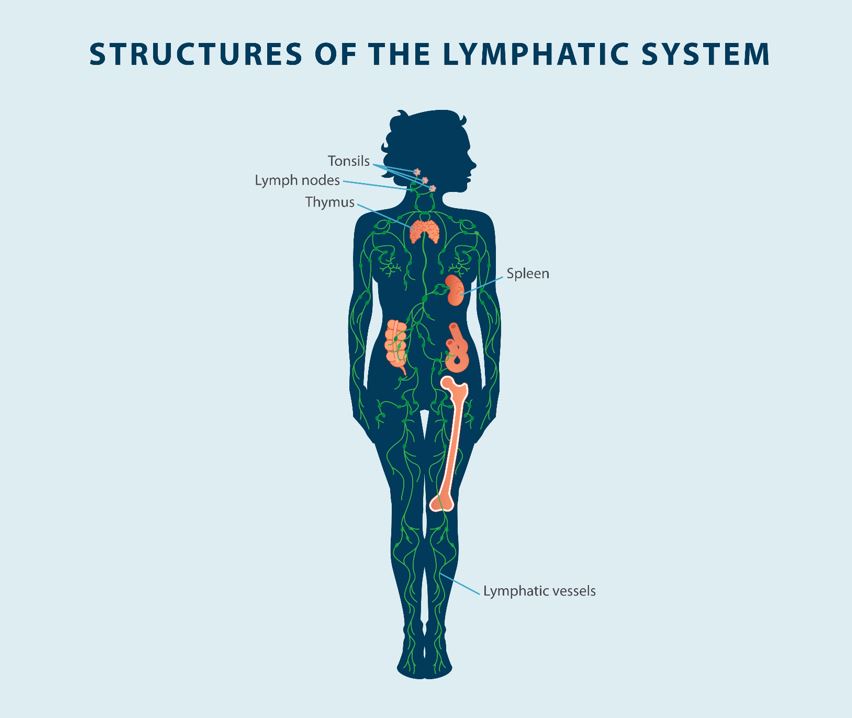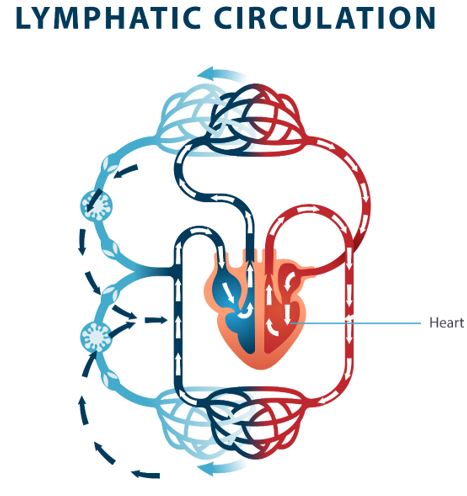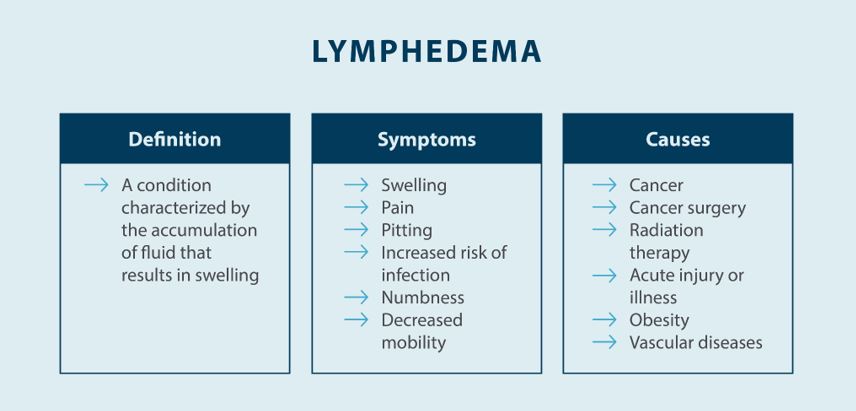Inflammation vs Swelling
Review our guide on the differences between inflammation vs. swelling, so you can understand how they impact your body differently.
Read More

The lymphatic system is a vital yet often overlooked part of your immune system. Through an expansive network of lymph nodes, vessels, and organs, your lymphatic system helps to regulate fluid levels in the body and support the functions of your immune system. Lymphatic circulation can be viewed as a drainage system for your body, which functions by taking fluid that has seeped into your body’s tissues and returning it to the bloodstream. In the process, your lymphatic circulation system filters the fluid and works to remove toxins and potentially harmful waste. In this article, we go into more detail about what lymphatic circulation is, how it works, why it is important, and methods for how to boost lymphatic circulation.
What Is the Lymphatic System?
What Are the Components of the Lymphatic System?
How Does Lymphatic System Circulation Work?
What Can Happen If There Is a Disruption to Lymphatic Circulation?
How Can You Improve Lymphatic Circulation?
Key Takeaways: Lymphatic Circulation
The lymphatic system refers to the large network of organs, blood vessels, lymph nodes, and lymph fluid that are tasked with managing the body’s fluid levels and filtering fluid to prevent health complications. As a part of the immune system, the lymphatic circulation system plays an important role in fighting off infections and ridding the body of cellular waste and toxins.
Lymph fluid, vessels, and nodes play key roles in the lymphatic system. As blood pumps through the body, fluid escapes through the thin walls of the blood vessels and collects in the body’s tissues. The lymphatic system is primarily responsible for the uptake of this excess fluid to filter and return good fluids to the bloodstream.1
Overall, lymphatic circulation can only occur effectively when every element within the complex lymphatic system does its job. If elements of the lymphatic system fail, this can lead to a number of complications, such as swelling, infections, lymphedema, and more. In the following sections, we will go into more detail about the different elements that contribute to lymphatic circulation and explain the complications that may arise if the lymphatic flow becomes interrupted.
As we have already mentioned, the lymphatic system is made up of many different structures, each of which serves a unique purpose in ensuring healthy lymphatic circulation. By learning about the different structures that make up the lymphatic system and the role they play in facilitating lymphatic circulation, you can better understand what lymphatic circulation is and why it is important. Below are some of the key nodes, organs, and vessels that the body’s lymphatic system consists of.

Lymph: Lymph is a clear-to-white fluid that circulates throughout the lymphatic system. Lymph is formed when interstitial fluid leaves the body tissues and enters the lymphatic vessels. Lymph fluid largely consists of special white blood cells called lymphocytes and is collected and filtered by your lymphatic system as it accumulates. If an issue with the lymphatic system occurs, lymph fluid can build up and cause problems, such as edema and lymphedema.
As your heart beats, it pumps blood throughout the body and is transported via large arteries, smaller arterioles, and smaller blood vessels known as capillaries. The walls of these capillaries are very thin and, as a result, blood plasma can leak out of the vessels and into the body tissues. The elements of the blood plasma that seep into the body tissue are known as interstitial fluid or extracellular fluid, which contain oxygen, glucose, amino acids, and various other nutrients.

As fluid escapes the capillary walls it collects in the body’s tissues. For the body to maintain a healthy fluid balance, the lymphatic system picks up the excess fluid—known as lymphatic fluid—to filter and return good fluids to the bloodstream. Your lymphatic system collects this leftover fluid, and it passes through your lymph nodes, where toxins and other potentially harmful bacteria are filtered out.
Once the lymph fluid has been filtered, the lymphatic flow returns the fluid—now containing broken-down bacteria and waste products—to the bloodstream. The broken-down waste products in the blood are then removed by the liver or kidneys and leave your body via stool or urine.
In some cases, your lymph nodes might not immediately break down harmful substances and instead trap them for certain periods of time. This is why you may notice your lymph nodes swell up and experience soreness when you become sick or deal with an infection.5
A healthy lymphatic flow is essential for maintaining your overall health and fighting off cancer. This is because when cancer forms at one site, it can travel across the body through blood or lymph fluid. Lymph nodes can filter out cancer cells and other foreign substances, preventing them from spreading to vulnerable areas in the body. But, at the same time, cancer cells can spread to—or even originate from—the lymph nodes themselves, causing the lymph nodes to swell. Thus, if you become aware of swollen lymph nodes, it is important to seek treatment and consult with your doctor.
When issues occur that impact the lymphatic system or disrupt lymphatic flow, this can lead to a variety of health problems. Your lymphatic system is tasked with filtering lymph fluid and maintaining healthy fluid levels in your body in support of your immune system—so what happens when there is a problem with circulation in the lymphatic system?
The most common lymphatic disorder is lymphedema. Lymphedema is a progressive disease characterized by an accumulation of fluid that leads to swelling, which can be uncomfortable or painful. Lymph fluid can accumulate due to damaged lymphatic vessels that prevent healthy lymphatic flow. Symptoms of lymphedema may include:

There are two types of lymphedema. Primary lymphedema is a rare condition that an individual is born with and potentially inherits from a parent. Secondary lymphedema, on the other hand, is much more common. There is a range of events that may lead to secondary lymphedema in an individual. Potential causes of secondary lymphedema include:
Lymphedema can lead to discomfort and pain and have an overall negative impact on your quality of life. While there is no cure for the condition, symptoms can be managed and the progression of the disease can be slowed or stopped. This is why it is important to recognize the signs and risk factors of lymphedema and take steps to support lymphatic system circulation and flow.
Whether you’re living with lymphedema or simply want to maintain the health of your lymphatic system, you may be wondering how to boost lymphatic circulation. Some tips include:

The lymphatic system is a key part of the body’s immune system. By regulating fluid levels in the body and filtering bacteria and waste, the lymphatic system keeps you healthy and functioning. Thus, maintaining healthy lymphatic circulation is important when it comes to managing your physical health.
However, sometimes for reasons beyond our control, problems can develop with the lymphatic system. Disruptions in the lymphatic system can lead to the development of lymphedema, which is characterized by swelling, tightness in the skin, and discomfort. If you do begin to notice swollen lymph nodes or abnormal swelling somewhere in your body, make sure to seek medical treatment sooner rather than later.
If you do have lymphedema, Tactile Medical offers solutions that allow you to self-manage edema, lymphedema, lipedema, and other related symptoms. Explore our website to see for yourself how our Flexitouch Plus system has provided relief for those dealing with these conditions.
References
1. Cleveland Clinic. Lymphatic System. https://my.clevelandclinic.org/health/articles/21199-lymphatic-system
2. MedlinePlus. https://medlineplus.gov/ency/article/002247.htm
3. InformedHealth.org. Cologne, Germany: Institute for Quality and Efficiency in Health Care (IQWiG); 2006-. How do the tonsils work? 2011 Mar 8.https://www.ncbi.nlm.nih.gov/books/NBK279406/
4. Brittanica. Lymphatic System. https://www.britannica.com/science/lymphatic-system#ref283751
5. Macmillan Cancer Support. The Lymphatic System. https://www.macmillan.org.uk/cancer-information-and-support/worried-about-cancer/the-lymphatic-system
6. American Cancer Society. What Is Lymphedema? https://www.cancer.org/treatment/treatments-and-side-effects/physical-side-effects/swelling/lymphedema/what-is-lymphedema.html
7. United Kingdom National Health Services. Lymphedema. NHS.uk. https://www.nhs.uk/conditions/lymphoedema/
Review our guide on the differences between inflammation vs. swelling, so you can understand how they impact your body differently.
Read More
Living with lymphedema while trying to manage your weight can feel overwhelming, but understanding the connection between lymphedema and weight loss can help you develop effective strategies for both conditions.
Read More
Review our guide on chronic venous insufficiency (CVI) to better understand the symptoms, causes, and treatment options to get the care you need.
Read More
Stage three lymphedema is the most advanced stage of this chronic condition. In this stage, the affected body part might display one or more symptoms, such as significant swelling, alterations in the skin, or recurring episodes of infection. While this stage can be challenging to manage, understanding your condition and...
Read More
Call us at 1.800.575.1900